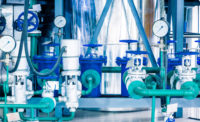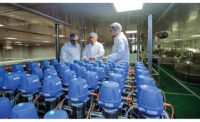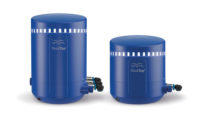Increased productivity and improved sustainability have propelled hygienic pigging systems into the spotlight for a variety of sanitary processors across the globe. A properly designed hygienic pigging system allows processors to recapture up to 99% of high value food, personal care, and other highly viscous products.
What is a Pigging System?
Hygienic pigging systems are used by liquid product manufacturers to recover residual product from process piping in food, beverage, personal care, and other sanitary processes. Without a sanitary pigging system, recovered product would instead be flushed down the drain during the facility’s cleaning process.
How It Works
Sanitary pigging systems, in their most basic form, are comprised of a “pig” transported through a pipeline by pressure (compressed air, water, or other force dependent on the application) behind it. The “pig” is used to push leftover product in the pipe to its designated destination (filler, mixing, etc.). The recovered product is then processed along with the rest of the batch.
The “pig” design differs slightly by manufacturer, but in general, it is a solid, but flexible projectile that is introduced, housed and returned to the pipeline through automatic pig launchers and receivers. Adding a hygienic pigging system to a sanitary process is straightforward in comparison to other system modifications, but there are some key factors to take into account, including considerations for piggable valves and smooth bore welds.
Benefits of Sanitary Pigging Systems
Sanitary pigging systems offer a high return on investment, including maximum product yield, less waste, decreased downtime, rapid changeovers, and lower utility consumption. A culmination of these benefits lead to overall increased process efficiency, productivity, sustainability, and profits.
Minimum Product Loss
Sanitary pigging systems help producers keep up with production demands by recapturing significant usable product from process piping. The result is drastically less waste and more end product to sell for consumer consumption.
Safe Separation of Product
Properly designed hygienic “pigs” ensure a high capture rate and reduces the chance of cross-contamination from product left in the pipe, ensuring customer health and well-being.
Reduced Cleaning Time and Increased Uptime
By starting a cleaning process with pipes that have been pigged, processors are one step ahead of the typical cleaning procedure. There is less product to remove reducing the effort and resources needed to clean process piping. Quicker, less intensive cleaning decreases labor costs, chemical use, water consumption and downtime.
Less time cleaning means more time producing. Sanitary pigging systems add to uptime through decreased cleaning times, process streamlining and flexibility.
Faster Changeovers
Keeping up with the rapidly changing consumer demands and the ability to offer a wide variety of product ranges has created a greater emphasis on manufacturing flexibility. Because producers don’t have the capacity to designate a single line for each product, high waste costs and production downtime have become pain points during product changeovers. Pigging systems speed up changeovers due to the reduced time allotment for the wash cycle.
Maximum Product Quality and Yield
Increased product yields are the most obvious benefit of sanitary pigging systems. Even the best designed sanitary process systems will have leftover product residual. Pigging systems recapture the residue and allow it to be useable product instead of waste. Pigging systems are particularly beneficial to producers that run any sticky, thick or viscous products regularly. The higher the product viscosity the greater the amount of leftover residue.
Reduced Water Waste and Use
Because a sanitary pigging system recovers a significant amount of product left in the pipe there is less product that goes to waste and clean-in-place processes require a reduced amount of cleaning chemicals and water. The results are a direct waste reduction through decreased waste processing and reduction of utilities usage.
Environmentally Sound
Pigging systems save water and reduce the number of hazardous chemicals associated with cleaning as well as contribute significantly to reduced waste. Not only are utilities, chemicals and waste processing costly but they negatively impact the environment. For environmentally conscious producers sanitary pigging systems offer significant benefits.
Is a Sanitary Pigging System Right for Your Process?
Hygienic pigging systems are not one-size-fit all solutions. Deployment of a pigging system in an existing process or new build require in-depth evaluation and specifications based on the particulars of the process. Consult a pigging system expert for full analysis and recommendation based on specific processing needs.
Any opinions expressed in this story are those of the author and do not necessarily reflect the views of Dairy Foods or its parent BNP Media.



